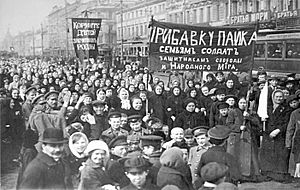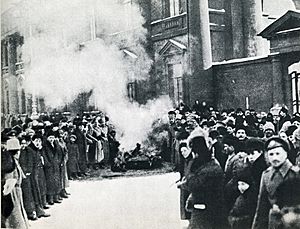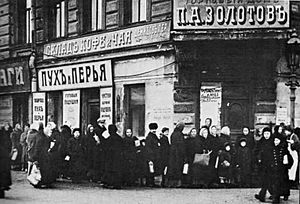February Revolution facts for kids
The February Revolution (Russian: Февральская Революция, Fevralskaya Revolyuziya) was a big change in Russia in 1917. It was a revolution that ended the rule of the Tsar, who was like a king, in the Russian Empire. After the Tsar, Nicholas II, stepped down, a new temporary government took over. This event was the start of the larger Russian Revolution. The February Revolution happened because of many problems, especially those left over from World War I. These problems included money troubles and other difficulties that made people very unhappy.
Contents
How the Revolution Started
Russia's Changing Economy
Russia started to become more industrialized in the late 1800s and early 1900s. This meant more factories and cities. After Russia lost the Crimean War in 1856 to England and France, it was clear that the country needed to change.
Many big reforms happened. For example, serfdom was ended in 1861. Serfs were like farmers who were tied to the land and belonged to rich landowners. This change gave them more freedom. New local government groups, called Zemstvos, were also created. These changes helped Russia grow its industries.
Money Problems and New Ideas
Russia faced money problems, especially during the Crimean War. The Tsar, who was Russia's emperor, had not updated the country's weapons and machines. After the war, he tried to fix this by building more factories. This was very expensive and cost the Russian people a lot of money.
Changes in how people lived and thought happened mostly in the cities. New laws were made to help local leaders manage the growing industries. People started to read more newspapers and discuss new ideas. This led to a group of educated people, called the intelligentsia, who wanted reforms. They were less willing to be controlled by the government.
Farmers and Their Protests
Around 1916, most people in Russia were still farmers. So, a revolution couldn't happen without them. Farmers often protested when they were unhappy, but these protests were usually short and local. They would go back home once they got what they wanted. This happened in 1905 and again in 1917.
When World War I started in 1914, things became quiet in the countryside. Most young men from the villages joined the army. This meant there were fewer people left to protest against the government.
Farmers usually protested against their local landlords, not against the Tsar or the government in the cities. But for the revolution to truly happen, farmers and city people needed to work together. The revolution's start was connected to these long-term changes in how people lived and thought.
Losses in World War I
World War I brought terrible losses to Russia. Over a million Russian soldiers died. At first, people were very patriotic when the war began. But after a big defeat in 1915, Russia suffered many more losses.
The Tsar, Nicholas II, decided to take personal command of the army. This was a bad idea because every defeat made him look weak. It hurt his reputation and the trust people had in his rule.
The war made all of Russia's existing problems much worse. The unhappiness of workers and farmers grew. The feeling of national unity that existed at the start of the war quickly disappeared. By September 1915, when the Tsar sent the parliament (Duma) home again, tensions were very high. It became almost impossible to find a peaceful solution.
Tsar Nicholas II Loses Power
Tsar Nicholas II made many people angry. He ordered the killing of political opponents and set up a system of spies. In 1915, he took charge of the army during World War I. After this, the Russian army faced many embarrassing defeats.
He also allowed his secret police and soldiers to shoot at protesters. He tried to stop any rebellion before it could grow. Eventually, Nicholas II had to allow elections for the Duma, which was like a parliament.
Nicholas II ignored good advice from his former Minister of Finance, Sergei Witte, who suggested big reforms. The Tsar often broke promises. The start of World War I was the beginning of the end for his rule. Many defeats, food shortages, and terrible living conditions for the people eventually led to the revolution.
The promise of peace during the war, which was supposed to keep the opposition quiet, quickly broke down. People became more and more ready to protest. The Duma, which had representatives from the middle class and rich families, showed this anger. By 1915, a group called the Progressive Bloc formed in the Duma. They were very upset with Nicholas II's rule. This group was the strongest opposition to the Tsar since the 1905 revolution.
Images for kids
-
Protesters on Znamensky Square in front of the statue of Alexander III
-
A revolutionary meeting of Russian soldiers in March 1917 in Dalkarby of Jomala, Åland
See also
 In Spanish: Revolución de Febrero para niños
In Spanish: Revolución de Febrero para niños
















